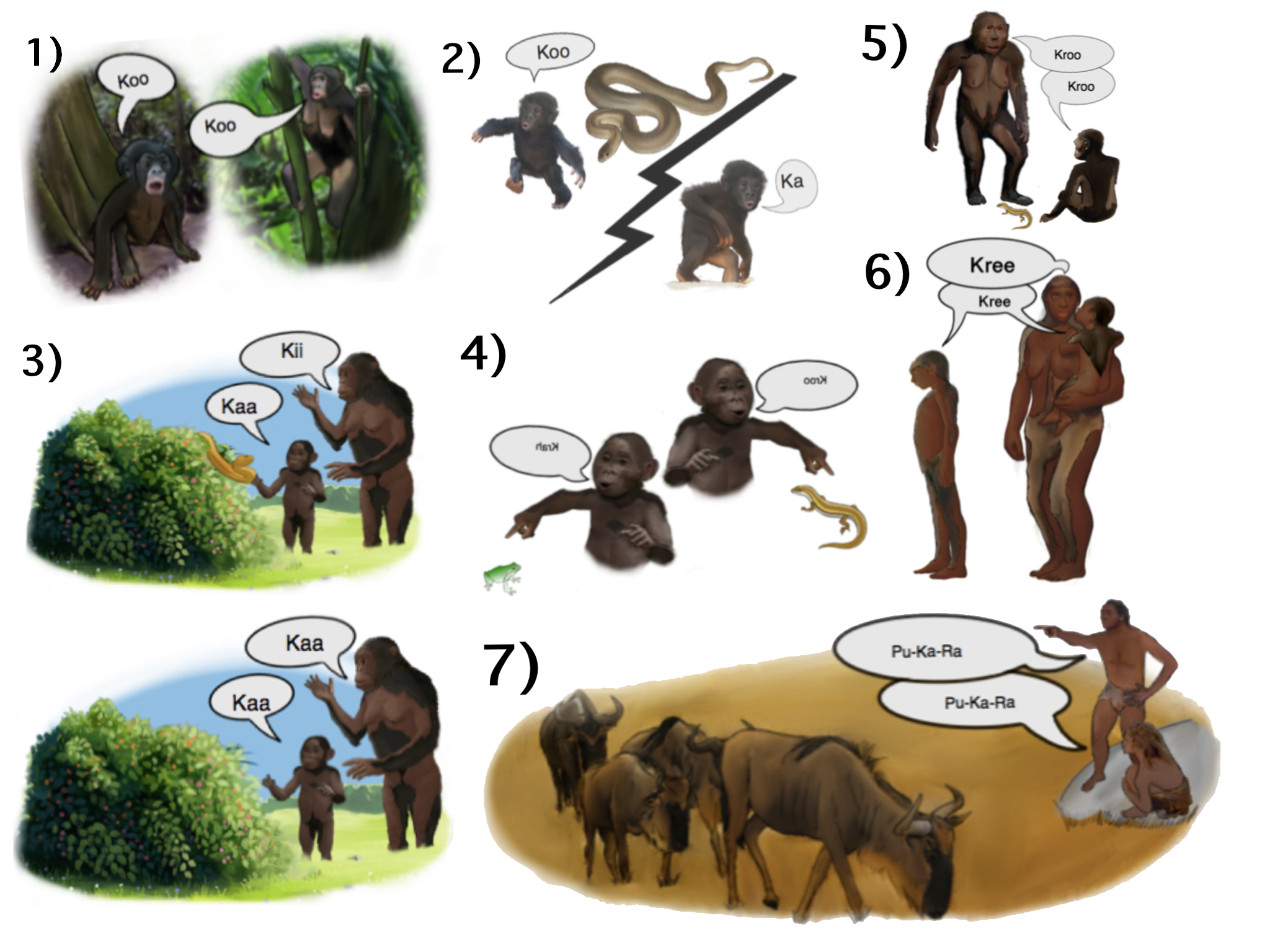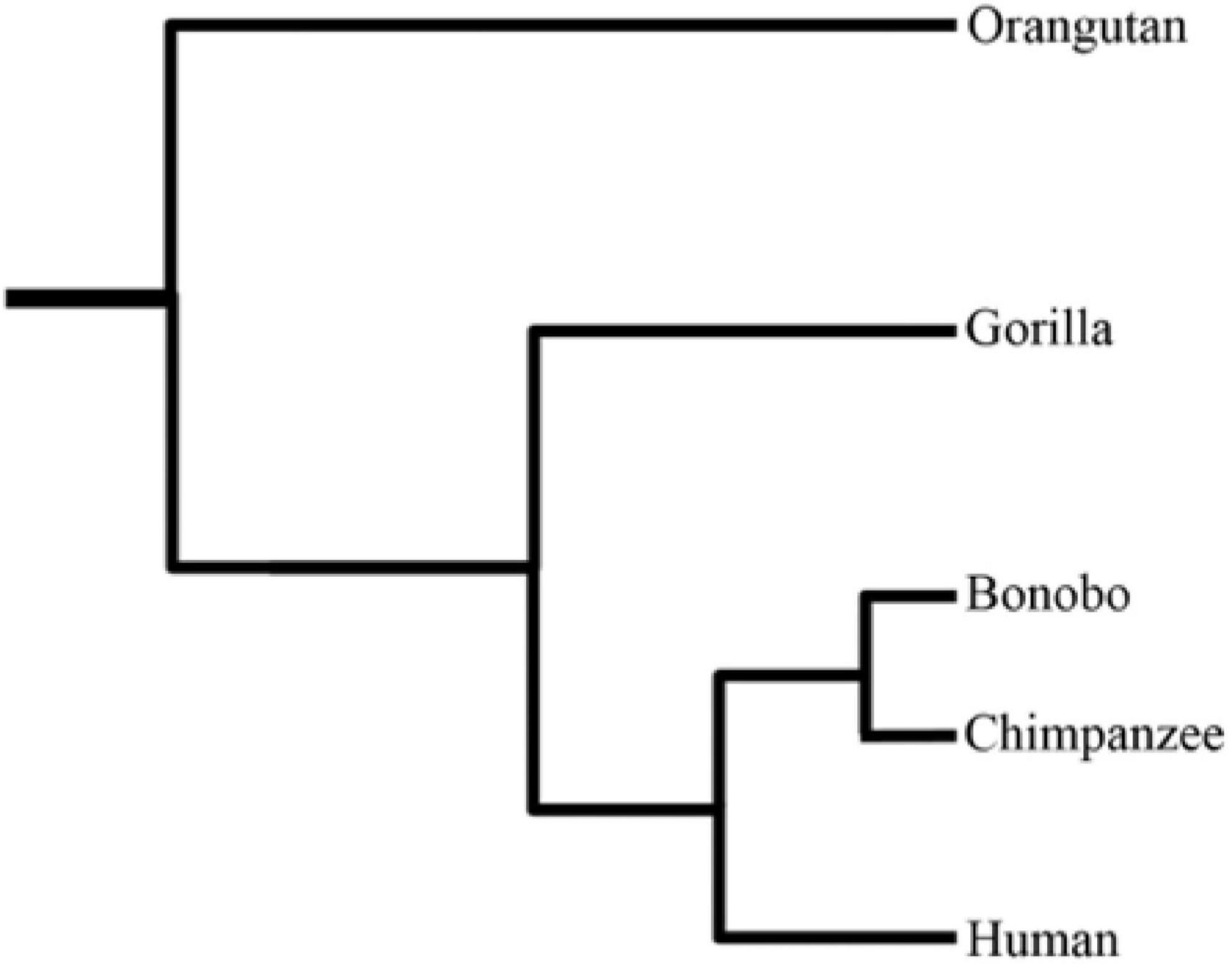|
Lana (chimpanzee)
Lana (October 7, 1970 - November, 2016) was a female chimpanzee, the first to be used in language research using lexigrams. She was born at the Yerkes National Primate Research Center of Emory University, and the project she was allocated to when 1 year old, the LANguage Analogue project led by Duane Rumbaugh, was named after her with the acronym LANA because the project team felt that her identity was well worth preserving.(Rumbaugh, 1977, p. XXI) LANA project The researchers stated Lana showed that she could discriminate between lexigrams, sequence words grammatically and make novel utterances, demonstrating language learning. The first LANA project (1971) officially had two Principal Investigators, Rumbaugh and Ernst von Glasersfeld (cf. NIH grants HD-06016 and RR-00165). Ernst von Glasersfeld developed the language that Lana learned to use: he coined the term " lexigram", created the first 120 of them and designed the grammar that regulated their combination. This artif ... [...More Info...] [...Related Items...] OR: [Wikipedia] [Google] [Baidu] |
Emory University
Emory University is a private research university in Atlanta, Georgia. Founded in 1836 as "Emory College" by the Methodist Episcopal Church and named in honor of Methodist bishop John Emory, Emory is the second-oldest private institution of higher education in Georgia. Emory University has nine academic divisions: Emory College of Arts and Sciences, Oxford College, Goizueta Business School, Laney Graduate School, School of Law, School of Medicine, Nell Hodgson Woodruff School of Nursing, Rollins School of Public Health, and the Candler School of Theology. Emory University, the Georgia Institute of Technology, and Peking University in Beijing, China jointly administer the Wallace H. Coulter Department of Biomedical Engineering. The university operates the Confucius Institute in Atlanta in partnership with Nanjing University. Emory has a growing faculty research partnership with the Korea Advanced Institute of Science and Technology (KAIST). Emory University students ... [...More Info...] [...Related Items...] OR: [Wikipedia] [Google] [Baidu] |
Washoe (chimpanzee)
Washoe (c. September 1965 – October 30, 2007) was a female common chimpanzee who was the first non-human to learn to communicate using American Sign Language (ASL) as part of an animal research experiment on animal language acquisition. Washoe learned approximately 350 signs of ASL, also teaching her adopted son Loulis some signs. She spent most of her life at Central Washington University. Early life Washoe was born in West Africa in 1965. She was captured for use by the US Air Force for research for the US space program. Washoe was named after Washoe County, Nevada, where she was raised and taught to use ASL. In 1967, R. Allen Gardner and Beatrix Gardner established a project to teach Washoe ASL at the University of Nevada, Reno. At the time, previous attempts to teach chimpanzees to imitate vocal languages (the Gua and Viki projects) had failed. The Gardners believed that these projects were flawed because chimpanzees are physically unable to produce the voiced sounds ... [...More Info...] [...Related Items...] OR: [Wikipedia] [Google] [Baidu] |
Apes From Language Studies
Apes (collectively Hominoidea ) are a clade of Old World simians native to sub-Saharan Africa and Southeast Asia (though they were more widespread in Africa, most of Asia, and as well as Europe in prehistory), which together with its sister group Cercopithecidae form the catarrhine clade, cladistically making them monkeys (though this is the subject of much debate). Apes do not have tails due to a mutation of the TBXT gene. In traditional and non-scientific use, the term "ape" can include tailless primates taxonomically considered Cercopithecidae (such as the Barbary ape and black ape), and is thus not equivalent to the scientific taxon Hominoidea. There are two extant branches of the superfamily Hominoidea: the gibbons, or lesser apes; and the hominids, or great apes. * The family Hylobatidae, the lesser apes, include four genera and a total of 20 species of gibbon, including the lar gibbon and the siamang, all native to Asia. They are highly arboreal and bipedal on the g ... [...More Info...] [...Related Items...] OR: [Wikipedia] [Google] [Baidu] |
Panbanisha
Panbanisha (November 17, 1985 – November 6, 2012), also known by the lexigram , was a female bonobo that featured in studies on great ape language by Professor Sue Savage-Rumbaugh. Her name is Swahili for "to cleave together for the purpose of contrast." Biography Panbanisha was born at Language Research Center at Georgia State University in Atlanta, Georgia, United States. Panbanisha was the daughter of Matata, the adopted mother of the famous Kanzi, who also was an intelligent bonobo, and was the mother of two sons, Nyota and Nathen. Panbanisha resided at the Great Ape Trust in Iowa, where ape behavior and intelligence is studied. She was able to express her sadness through Yerkish when her half-brother Kanzi had to leave . During the studies, Dr. Savage-Rumbaugh had recognized the ability of communication and understanding of complex sentences. She died of a cold at the Great Ape Trust on November 6, 2012. She was 26 years old. Research The basis of the early ... [...More Info...] [...Related Items...] OR: [Wikipedia] [Google] [Baidu] |
Evolution Of Language
The origin of language (spoken and signed, as well as language-related technological systems such as writing), its relationship with human evolution, and its consequences have been subjects of study for centuries. Scholars wishing to study the origins of language must draw inferences from evidence such as the fossil record, archaeological evidence, contemporary language diversity, studies of language acquisition, and comparisons between human language and systems of communication existing among animals (particularly other primates). Many argue that the origins of language probably relate closely to the origins of modern human behavior, but there is little agreement about the facts and implications of this connection. The shortage of direct, empirical evidence has caused many scholars to regard the entire topic as unsuitable for serious study; in 1866, the Linguistic Society of Paris banned any existing or future debates on the subject, a prohibition which remained influenti ... [...More Info...] [...Related Items...] OR: [Wikipedia] [Google] [Baidu] |
Akeakamai
Akeakamai (c. 1976 – November 12, 2003) (Nickname: Ake ("ah-KAY")) was a female Atlantic bottlenose dolphin, who, along with a companion female dolphin named Phoenix, and later tankmates Elele and Hiapo, were the subjects of Louis Herman's animal language studies at the Kewalo Basin Marine Mammal Laboratory in Honolulu, Hawaii. The most well-known paper is the original work described in Herman, Richards, & Wolz (1984). Akeakamai was also the subject of many other scientific studies of dolphin cognition, language acquisition, and sensory abilities. Physically identifying features of Akeakamai included a straight eye line, a half-circle-shaped notch in the right side of her tail fluke, a small "Eiffel Tower"-shaped mark above her right eye, a thin notch in the side of her upper mouth, and a particularly wide melon. She also had characteristic in-air whistle calls, including an unusual high-low-high whistle that was well below typical signature whistle frequencies. In the Hawaii ... [...More Info...] [...Related Items...] OR: [Wikipedia] [Google] [Baidu] |
Alex (parrot)
Alex (May 1976 – 6 September 2007) was a grey parrot and the subject of a thirty-year experiment by animal psychologist Irene Pepperberg, initially at the University of Arizona and later at Harvard University and Brandeis University. When Alex was about one year old, Pepperberg bought him at a pet shop. In her book "Alex & Me", Pepperberg describes her unique relationship with Alex and how Alex helped her understand animal minds. Alex was an acronym for avian language experiment, or avian learning experiment. He was compared to Albert Einstein and at two years old was correctly answering questions made for six-year-olds. Before Pepperberg's work with Alex, it was widely believed in the scientific community that a large primate brain was needed to handle complex problems related to language and understanding; birds were not considered to be intelligent, as their only common use of communication was mimicking and repeating sounds to interact with each other. However, Alex's accom ... [...More Info...] [...Related Items...] OR: [Wikipedia] [Google] [Baidu] |
List Of Individual Apes
This is a list of non-human apes of encyclopedic interest. It includes individual chimpanzees, gorillas, orangutans, bonobos, and gibbons that are in some way famous or notable. Actors * Bam Bam, an orangutan, played Precious on the soap opera ''Passions''. * Buddha, an orangutan, played Clyde in the Clint Eastwood action-comedy film ''Any Which Way You Can'' (1980). Buddha was allegedly beaten to death by his trainer for stealing doughnuts from craft services. The weapon was an axe handle wrapped in newspaper and had been nicknamed a "Buddha club" since it had been previously used to discipline him. This claim has been disputed by the author William Munns. * Çarli (born 1993), a chimpanzee, starred in the live-action movie ''The Jungle Book'' (1994) and in the Turkish television series ''Çarli'' before retiring to Monkey World in Dorset, UK. * C.J., an orangutan, played in the 1981 film ''Tarzan the Ape Man''. * Clara, a chimpanzee, played Livingston in the movie comedy ''D ... [...More Info...] [...Related Items...] OR: [Wikipedia] [Google] [Baidu] |
Nim Chimpsky
Neam "Nim" Chimpsky (November 19, 1973 – March 10, 2000) was a chimpanzee and the subject of an extended study of animal language acquisition at Columbia University. The project was led by Herbert S. Terrace with the linguistic analysis headed up by psycholinguist Thomas Bever. Within the context of a scientific study, Chimpsky was named as a pun on linguist Noam Chomsky, who posits that humans are "wired" to develop language. As part of a study intended to challenge Chomsky's thesis that only humans have language, beginning at two weeks old, Nim was raised by a family in a home environment by human surrogate parents. The surrogate parents already had a human child of their own. At the age of two Nim was removed from his surrogate parents, the familiar surrounding of their home and brought to Columbia University due to perceived behavioral difficulties. The project was similar to an earlier study by R. Allen and Beatrix Gardner in which another chimpanzee, Washoe, was rai ... [...More Info...] [...Related Items...] OR: [Wikipedia] [Google] [Baidu] |
Kanzi
Kanzi (born October 28, 1980), also known by the lexigram (from the character 太), is a male bonobo who has been the subject of several studies on great ape language. According to Sue Savage-Rumbaugh, a primatologist who has studied the bonobo throughout her life, Kanzi has exhibited advanced linguistic aptitude. Despite his achievements in the use of language, Kanzi could still not approach the levels of an average 3-year-old child. Biography Kanzi was born to Lorel and Bosandjo at Yerkes Field Station at Emory University in 1980. Shortly after birth Kanzi was stolen and adopted by a more dominant female, Matata, the matriarch of the group. In 1985, Kanzi was moved to the Language Research Center at Georgia State University. He was later relocated, along with his sister, Panbanisha, to the Great Ape Trust, in Des Moines, Iowa. The ill-fated facility, founded in 2004 by local businessman, Ted Townsend, closed after losing funding, experiencing allegations of neg ... [...More Info...] [...Related Items...] OR: [Wikipedia] [Google] [Baidu] |
Common Chimpanzee
The chimpanzee (''Pan troglodytes''), also known as simply the chimp, is a species of great ape native to the forest and savannah of tropical Africa. It has four confirmed subspecies and a fifth proposed subspecies. When its close relative the bonobo was more commonly known as the pygmy chimpanzee, this species was often called the common chimpanzee or the robust chimpanzee. The chimpanzee and the bonobo are the only species in the genus ''Pan''. Evidence from fossils and DNA sequencing shows that ''Pan'' is a sister taxon to the human lineage and is humans' closest living relative. The chimpanzee is covered in coarse black hair, but has a bare face, fingers, toes, palms of the hands, and soles of the feet. It is larger and more robust than the bonobo, weighing for males and for females and standing . The chimpanzee lives in groups that range in size from 15 to 150 members, although individuals travel and forage in much smaller groups during the day. The species lives i ... [...More Info...] [...Related Items...] OR: [Wikipedia] [Google] [Baidu] |
Koko (gorilla)
Hanabiko "Koko" (July 4, 1971 – June 19, 2018) was a female western lowland gorilla. Koko was born in San Francisco Zoo, and lived most of her life at The Gorilla Foundation's preserve in the Santa Cruz Mountains. The name , , is of Japanese origin and is a reference to her date of birth, Independence Day (United States), the Fourth of July. Koko gained public attention upon a report of her having adopted a kitten as a pet and naming him "All Ball", which the public perceived as her ability to rhyme. Her instructor and caregiver, Francine Patterson, reported that Koko had an active vocabulary of more than 1,000 signs of what Patterson calls "Gorilla Sign Language" (GSL). This puts Koko's vocabulary at the same level as a three-year-old human. In contrast to other experiments attempting to teach sign language to non-human primates, Patterson simultaneously exposed Koko to spoken English from an early age. It was reported that Koko understood approximately 2,000 words of spoken Eng ... [...More Info...] [...Related Items...] OR: [Wikipedia] [Google] [Baidu] |


.jpg)




